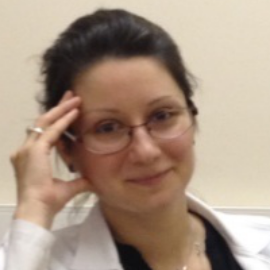
Mayorova L.A.
Work place: The Institute of Higher Nervous Activity and Neurophysiology of the RAS Moscow, Russian Federation
E-mail:
Website:
Research Interests: Speech Recognition, Speech Synthesis, Models of Computation
Biography
Mayorova Larisa Alekseevna is M.D., Ph.D. in medical sciences, a researcher at the Institute of Higher Nervous Activity and Neurophysiology of the RAS, a senior researcher at the Scientific and Clinical Center of Psychoneurology. She has more than 40 scientific publications. Mayorova is an expert in the field of functional neuroimaging and physiology of higher mental functions. She was graduated from the Lomonosov Moscow State University (MSU), the faculty of basic medicine (2010). Her theme of the master's thesis (2010) was "Cognitive evoked potential P300 in diagnosing cognitive deficits in patients with aphasia". Her theme of Ph.D thesis (2013) was "Reorganisation of speech recognition processes in patients with isolated sensory aphasia after stroke: an fMRI data". Scientific interests: stroke, aphasia, neurophysiology of speech comprehension, neuroimaging, neurorehabilitation.
Author Articles
Neural Network Modeling and Correlation Analysis of Brain Plasticity Mechanisms in Stroke Patients
By Stepanyan I.V. Mayorova L.A. Alferova V.V. Ivanova E.G. Nesmeyanova E.S. Petrushevsky A.G. Tiktinsky-Shklovsky V.M.
DOI: https://doi.org/10.5815/ijisa.2019.06.03, Pub. Date: 8 Jun. 2019
The aim of this research is the study of pathogenic signs, prognostically significant for the outcome of the disease and restoration of impaired functions at various stages of recovery after a stroke. This work describes a new method of applying a group of artificial neural network algorithms for each of the criteria and for each period of rehabilitation, and it is aimed at analyzing the structural and functional support of motor and higher cognitive functions, including speech and language as well as brain plasticity after ischemic stroke. The functional magnetic resonance imaging (fMRI, DTI) and clinical data machine learning algorithms were used. Self-organizing Kohonen and probabilistic neural network-based models with different structures and parameters were developed and applied for each criterion for periods of 3, 6, and 12 months of rehabilitation. For correlation analyses and modeling additional classifiers, we used: Decision Tree (DT), Support Vector Machine (SUM), k-Nearest Neighbor (KNN) clustering, and Logistic Regression (LR). In the performance evaluation, sensitivity, specificity, accuracy, error rate, and f-measure were used. The using of clinical parameters and mathematical modeling for analysis of brain plasticity mechanisms in stroke patients allowed in some cases to predict cognitive functions within the accuracy of 85-97%. Moreover, it is shown that the functional systems is represented by various brain structures, its synchronous activity and structural connectivity ensures the rapid and most complete restoration of motor and higher cognitive functions, including speech and language (effective post-stroke plasticity of the brain) after a course of neurorehabilitation.
[...] Read more.Other Articles
Subscribe to receive issue release notifications and newsletters from MECS Press journals